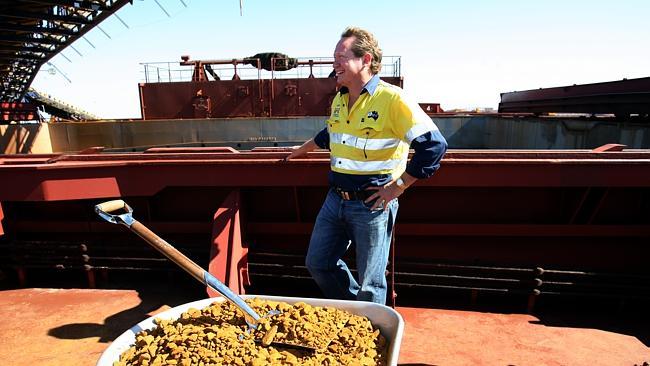Vale deal opens door for Forrest’s stake sale
The Fortescue-Vale deal provides a possible route for Andrew Forrest to sell some of his stake to the Brazilians.

Fortescue chairman Andrew Forrest didn’t take calls on the seemingly win-win deal between his third force in the Pilbara and Brazil’s Vale, the world’s biggest iron ore producer.
That’s a pity because there is a burning question that needs to be asked about the link-up of the two: does the non-binding memorandum of understanding between the pair provide a possible route for Forrest to sell down his Fortescue stake to the company’s new Brazilian friend?
It does.
Thanks to his bold invention of the third force in the Pilbara over a kitchen table in 2003, Forrest to this day holds a well-deserved one-third of the company, worth $2.9 billion (and $6.2bn at Fortescue’s share price height back in 2012 when iron ore was $US190 a tonne, if you don’t mind).
The MOU has a number of elements. First there is the formation of an iron ore blending joint venture and a less formal understanding around investment in current and future mining assets.
All that needs to be said on that is that the blending joint venture could add a couple of bucks a tonne to the realised prices Fortescue and Vale receive, with the latter’s benefit worth as much as $US200 million annually.
Second, the agreement also provides a framework for the potential investment by Vale in Fortescue’s shares, initially said by Fortescue to be up to a maximum of 15 per cent of its existing shares, and refined later in the day to be between 5 per cent and 15 per cent.
Such a stake would have cost Vale between $434m and $1.28bn on yesterday’s Fortescue market capitalisation. Going back to that $US200m annual benefit from the blending joint venture, an acquisition of a 5-15 per cent stake would have a super-quick payback for Vale.
If the MOU had stopped at the blending deal and there was no add-on around 5-15 per cent of Fortescue’s equity being part of the understanding, there would have been no need to ask if Forrest agreed that having a flagged buyer like Vale of 5-15 per cent of Fortescue’s stock would make a selldown by him all that easier.
Now, none of that is to say that when Forrest made contact with his counterpart at Vale in June last year with the big idea of a blending joint venture — with the add-on of Vale buying 5-15 per cent of the company — that he was out to smooth things for the day he sells down his Fortescue stake. Like all good chairmen, he would have made the contact with Vale with the best interests of all shareholders at heart. And as stated earlier, it does look like a win-win for both sides of the MOU.
It can be assumed that if Forrest was talking, he would have said he was a buyer, not a seller, of Fortescue because of the benefits of the MOU. Maybe so, but it is clear that the 5-15 per cent stake, which it is contemplated Vale could acquire, would be existing shares.
Forrest has lots of those — too many under any normal understanding of wealth preservation through diversification. The sale of a 5, 10 or 15 per cent stake by him in a block trade at a discount to the market to a quality partner like Vale would now not surprise — if it were to ever happen.
And as for the babble about Fortescue’s 21 per cent share price jump on Monday ahead of the Vale deal being the sort of the thing the stock-watching regulators need to have a look at, everyone needs to cool down. The price spike was all about what was happening in the offshore futures and spot markets for iron ore on Monday afternoon, nothing else.



To join the conversation, please log in. Don't have an account? Register
Join the conversation, you are commenting as Logout